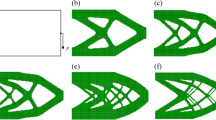Abstract
Although graph drawing has been extensively studied, little attention has been paid to the problem of node overlapping. The problem arises because almost all existing graph layout algorithms assume that nodes are points. In practice, however, nodes may be labelled, and these labels may overlap. Here we investigate how such node overlapping can be removed in a subsequent layout adjustment phase. We propose four different approaches for removing node overlapping, all of which are based on constrained optimization techniques. The first is the simplest. It performs the minimal linear scaling which will remove node-overlapping. The second approach relies on formulating the node overlapping problem as a convex quadratic programming problem, which can then be solved by any quadratic solver. The disadvantage is that, since constraints must be linear, the node overlapping constraints cannot be expressed directly, but must be strengthened to obtain a linear constraint strong enough to ensure no node overlapping. The third and fourth approaches are based on local search methods. The third is an adaptation of the EGENET solver originally designed for solving general constraint satisfaction problems, while the fourth approach is a form of Lagrangian multiplier method, a well-known optimization technique used in operations research. Both the third and fourth method are able to handle the node overlapping constraints directly, and thus may potentially find better solutions. Their disadvantage is that no efficient global optimization methods are available for such problems, and hence we must accept a local minimum. We illustrate all of the above methods on a series of layout adjustment problems.
Similar content being viewed by others
References
Aarts, E. H. L., & Korst, J. H. M. (1989). Boltzmann machines for traveling salesman problems. European Journal of Operational Research, 39: 79–95.
Adorf, H., & Johnston, M. (1990). A discrete stochastic neural network algorithm for constraint satisfaction problems. In Proceedings of the International Joint Conference on Neural Networks, pages 917–924.
Böhringer, K., & Paulisch, F. N. (1990). Using constraints to achieve stability in automatic graph layout algorithms. In CHI'90 Proceedings, pages 43–51, ACM.
Borning, A., Marriott, K., Stuckey, P., & Xiao, Y. (1997). Solving linear arithmetic constraints for user interface applications. In Proceedings of the 1997 ACM Symposium on User Interface Software and Technology, pages 87–96.
Davenport, A., Tsang, E. P. K., Wang, C. J., & Zhu, K. (1994). GENET: A connectionist architecture for solving constraint satisfaction problems by iterative improvement. In Proceedings of AAAI'94, pages 325–330.
di Battista, T., Eades, P., Tamassia, R., & Tollis, I. G. (1999). Graph Drawing: Algorithms for the Visualization of Graphs. Prentice Hall.
Dozier, G., Bowen, J., & Bahler, D. (1994). Solving small and large scale constraint satisfaction problems using a heuristic-based microgenetic algorithm. In Proceedings of the IEEE International Conference on Evolutionary Computation, pages 306–311.
Eades, P., Lai, W., Misue, K., & Sugiyama, K. (1991). Preserving the mental map of a diagram. Technical Report IIAS-RR-91-16E, International Institute for Advanced Study of Social Information Science, Fujitsu Laboratories
He, W., & Marriott, K. (1998). Removing node overlapping using constrained optimization. In Australasian Computer Science Conference, pages 169–180, Springer-Verlag.
Huang, M. L., Eades, P., & Wang, J. (1998). On-line animated visualization of huge graphs using a modified spring algorithm. Journal of Visual Languages and Computing, 9: 623–645.
Lee, J. H. M., Leung, H. F., & Won, H. W. (1995). Extending GENET for non-binary CSP's. In Proceedings of Seventh International Conference on Tools with Artificial Intelligence, pages 338–343.
Lee, J. H. M., Leung, H. F., & Won, H. W. (1996). Towards a more efficient stochastic constraint solver. In Proceedings of Principles and Practice of Constraint Programming (CP96), LNCS 1118, pages 338–352.
Leunberger, D. G. (1994). Linear and Nonlinear Programming. Addison-Wesley Publishing Company.
Lüders, P., Ernst, R., & Stille, S. (1995). An approach to automatic display layout using combinatorial optimization. Software-Practice and Experience, 25(11): 1183–1202.
Lyons, K. A. (1996). Cluster busting in anchored graph drawing. Ph.D. thesis, Department of Computing & Information Science Queen's University.
Mackworth, A. K. (1997). Consistency in networks of relations. AI Journal, 8(1): 99–118.
Minton, S., Johnston, M. D., Phillips, A. B., & Laird, P. (1992). Minimizing conflicts: a heuristic repair method for constraint satisfaction and scheduling problems. Artificial Intelligence, 58: 161–205.
Misue, K., Eades, P., Lai, W., & Sugiyama, K. (1995). Layout adjustment and the mental map. Journal of Visual Languages and Computing, 6: 183–210.
Papakostas, A., Six, J. M., & Tollis, I. G. (1997). Experimental and theoretical results in interactive orthogonal graph drawing. In Proceedings of International Symposium on Graph Drawing, GD'96, LNCS 1190, pages 371–386, New York: Springer.
Paulisch, F. N., & Tichy, W. F. (1990). Edge: an extendible graph editor. Software-Practice and Experience, 20(S1): 63–88.
Simmons, D. M. (1975). Nonlinear Programming for Operations Research. Englewood Cliffs, NJ: Prentice-Hall.
Storey, M. D., & Müller, H. A. (1995). Graph layout adjustment strategies. In Symposium on Graph Drawing, GD'95, LNCS 1027, pages 487–499, Springer-Verlag.
Tsang, E. (1993). Foundations of Constraint Satisfaction. Academic Press.
Voudoris, C., & Tsang, E., (1999). Guided local search and its application to the travelling saleman problem. European Journal of Operational Research, 11(2): 469–499.
Voudouris, C. (1997). Guided local search for combinatorial optimization problems. Ph.D. thesis, Department of Computer Science, University of Essex.
Voudouris, C., & Tsang, E. (1996). Partial constraint satisfaction problems and guided local search. In Proceedings of Practical Application of Constraint Technology, PACT96, pages 337–356.
Voudouris, C., & Tsang, E. (1999). Guided local search and its application to the traveling salesman problem. European Journal of Operational Research, 113: 469–499.
Walsh, G. R. (1975). Methods of Optimization. John Wiley and Sons.
Wang, C., & Tsang, E. (1991). Solving satisfaction problems using neural-networks. In Proceedings of IEE Second International Conference on Artificial Neural Networks, pages 295–299.
Author information
Authors and Affiliations
Rights and permissions
About this article
Cite this article
Marriott, K., Stuckey, P., Tam, V. et al. Removing Node Overlapping in Graph Layout Using Constrained Optimization. Constraints 8, 143–171 (2003). https://doi.org/10.1023/A:1022371615202
Issue Date:
DOI: https://doi.org/10.1023/A:1022371615202




